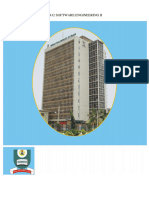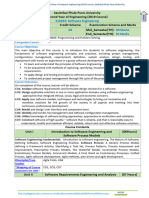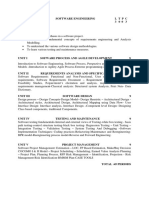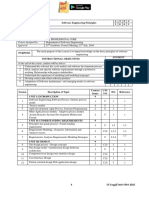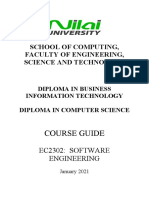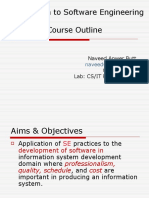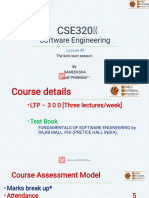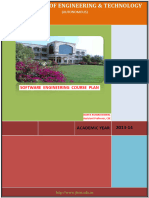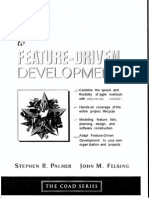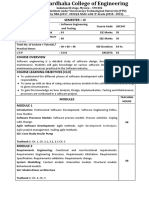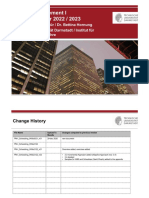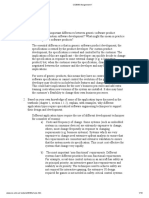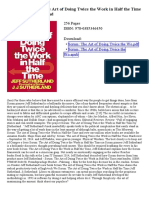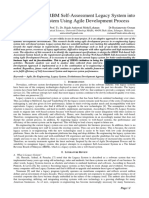8/17/25, 7:25 PM faculty.amizone.net/Academics/CourseCurriculumCDSRApprove/Index/?
CampusID=1&AcademicYear=2025-2026&CUID=C71646…
Course Curriculum
Course Code: IT612 Credit Units L T P/S SW AS/DS FW No. of PSDA Total Credit Unit
Course Level PG 3 0 0 2 0 0 0 4
Course Title Advanced Software Engineering Principles
Course Description
:
Course Objectives :
SN. Objectives
To provide a advanced understanding and knowledge of the software engineering techniques, techniques to collect software requirements
1
from client and CASE tools and to understand the importance of these case tools in software development.
Pre-Requisites : General
SN. Course Code Course Name
Course Contents / Syllabus :
SN. Module Descriptors / Topics Weightage
Waterfall Model Prototying Models Incremental Development Spiral Model Rapid Application
Module I Life Cycle
1 Development Componant Model Agile Software Development Selection of appropriate development 20.00
Models
process
Basic concepts Mathematical Preliminaries Mathematical notations for Formal Specification Formal
Module II Formal
2 Specification Languages Z-Notations Ten commandments of formal methods Formal Methods- The 20.00
Methods
Road Ahead
Module III Component-Based Software Engineering Engineering of Component-based Systems CBSE Process
Component-Based Domain Engineering Component-based Development Classifying and Retrieving Components
3 25.00
Software Economics of CBSE Cleanroom Software Engineering The Cleanroom Approach Functional Specification
Engineering Cleanroom Design Cleanroom Testing
Client/Server Software Engineering The Structure of Client/Server Systems Software Engineering for
Module IV Client Server Systems Analysis Modeling Issues Design for Client Server Systems Testing Issues. Web
Client/Server Engineering The Attributes of Web-based Applications WebE Process Framework for WebE
4 20.00
Software Formulating/Analyzing Web-based Systems Design for Web-based Applications Testing Web-based
Engineering Applications Management Issues. Service Oriented Software Engineering Services as Reusable
Components Service Engineering Software Development with Services
Reengineering Business Process Reengineering Software Reengineering Reverse Reengineering
Module V
Restructuring, Forward Reengineering Economics of Reengineering. Computer-Aided Software
5 Reengineering and 15.00
Engineering Introduction Building Blocks for CASE Taxonomy of CASE Tools Integrated CASE
CASE
Environments Integration Architecture CASE Repository Case Study of Tools like TCS Robot.
Course Learning Outcomes :
https://faculty.amizone.net/Academics/CourseCurriculumCDSRApprove/Index/?CampusID=1&AcademicYear=2025-2026&CUID=C71646AE-F256-4E… 1/3
�8/17/25, 7:25 PM faculty.amizone.net/Academics/CourseCurriculumCDSRApprove/Index/?CampusID=1&AcademicYear=2025-2026&CUID=C71646…
SN. Course Learning Outcomes
1 Analyze the software life cycle models;
2 Identify the importance of the software development process;
3 Analyze the importance of CASE tools;
4 Design and develop correct and robust software products using advanced software engineering techniques;
5 Able to Understand business requirements pertaining to software development.
Pedagogy for Course Delivery :
SN. Pedagogy Methods
The class will be taught using classroom teaching methodology. Students’ learning and assessment will be on the basis of four quadrants
1 and flipped class method. E-content will be also provided to the students for better learning. The class will be taught using theory, practical
and case-based method.
Theory /VAC / Architecture Assessment (L,T & Self Work): 100.00 Max : 100
Attendance+CE+EE : 5+35+60
SN. Type Component Name Marks
1 Attendance 5.00
2 End Term Examination (OMR) 60.00
3 Internal MID TERM EXAM 15.00
4 Internal CLASS QUIZ 5.00
5 Internal PRESENTATION 5.00
6 Internal INTEGRATED PROJECT 10.00
Lab/ Practical/ Studio/Arch. Studio/ Field Work Assessment : 0.00 Max : 100
N/A
List of Professional skill development activities :
No.of PSDA : 0
SN. PSDA Point
Text & References :
SN. Type Title/Name Description ISBN/ URL
Roger S. Pressman, Software Engineering
1 Book a Practitioners Approach, McGraw-Hill
(2008).
https://faculty.amizone.net/Academics/CourseCurriculumCDSRApprove/Index/?CampusID=1&AcademicYear=2025-2026&CUID=C71646AE-F256-4E… 2/3
�8/17/25, 7:25 PM faculty.amizone.net/Academics/CourseCurriculumCDSRApprove/Index/?CampusID=1&AcademicYear=2025-2026&CUID=C71646…
SN. Type Title/Name Description ISBN/ URL
J. Bowan, Formal Specification and
2 Book Documentation using Z - A Case Study
Approach, International Th
Diller, Z., An Introduction to Formal
3 Book Methods (second edition), Wiley, 2nd
edition (1994).
M. Dyer, The Cleanroon Approach to
4 Book Quality Software Development, Wiley
(1992).
Prowell, S., Trammell, C.J. and Poore, J.H,
5 Book Cleanroom Software Engineering:
Technology and Process,
Allen, Frost, Yourdon, Component-Based
6 Book Development for Enterprise Systems:
Applying the Select Persp
Zantinge and Adriaans, Managing
7 Book
Client/Server, Addison-Wesley (1996).
Print
https://faculty.amizone.net/Academics/CourseCurriculumCDSRApprove/Index/?CampusID=1&AcademicYear=2025-2026&CUID=C71646AE-F256-4E… 3/3






